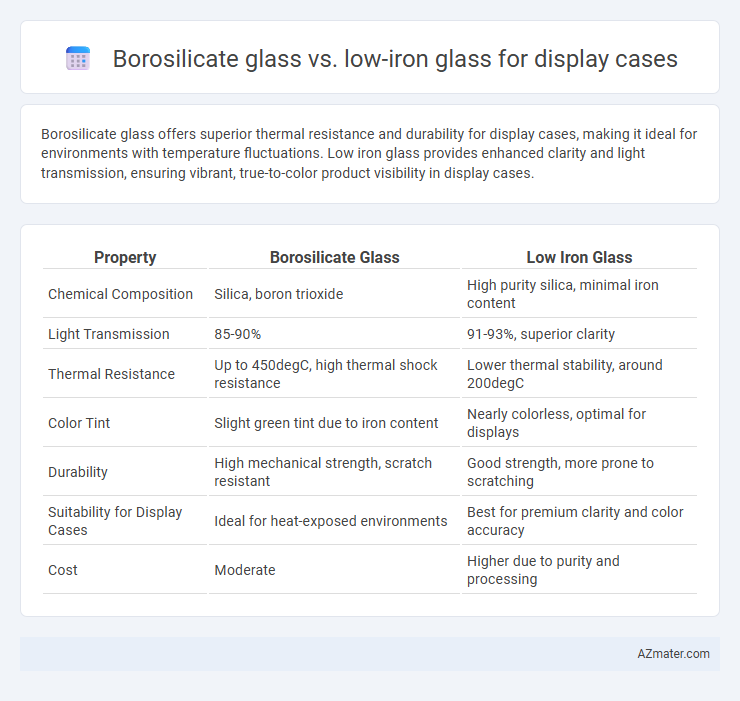Borosilicate glass offers superior thermal resistance and durability for display cases, making it ideal for environments with temperature fluctuations. Low iron glass provides enhanced clarity and light transmission, ensuring vibrant, true-to-color product visibility in display cases.
Table of Comparison
| Property | Borosilicate Glass | Low Iron Glass |
|---|---|---|
| Chemical Composition | Silica, boron trioxide | High purity silica, minimal iron content |
| Light Transmission | 85-90% | 91-93%, superior clarity |
| Thermal Resistance | Up to 450degC, high thermal shock resistance | Lower thermal stability, around 200degC |
| Color Tint | Slight green tint due to iron content | Nearly colorless, optimal for displays |
| Durability | High mechanical strength, scratch resistant | Good strength, more prone to scratching |
| Suitability for Display Cases | Ideal for heat-exposed environments | Best for premium clarity and color accuracy |
| Cost | Moderate | Higher due to purity and processing |
Introduction to Display Case Glass Options
Borosilicate glass offers exceptional durability and thermal resistance, making it ideal for display cases requiring high strength and minimal distortion. Low iron glass provides superior clarity and color neutrality, enhancing visibility and showcasing items with true-to-life colors. Both glass types serve distinct purposes in display cases, balancing durability and optical performance based on specific exhibition needs.
What is Borosilicate Glass?
Borosilicate glass is a type of glass known for its exceptional thermal resistance and durability, commonly used in display cases where temperature fluctuation and impact resistance are critical. It contains boron trioxide, which reduces thermal expansion, making it less prone to cracking or shattering compared to standard glass like low iron glass. While low iron glass offers higher clarity due to reduced green tint and is favored for aesthetic display purposes, borosilicate glass excels in functional strength and longevity under demanding conditions.
What is Low Iron Glass?
Low iron glass is a type of glass with reduced iron content, resulting in higher light transmission and superior clarity compared to standard glass, making it ideal for display cases where color accuracy and transparency are crucial. Borosilicate glass offers excellent thermal and chemical resistance but typically contains more iron, causing a slight greenish tint that can affect product visibility. Choosing low iron glass ensures minimal color distortion and maximum visibility, enhancing the visual appeal of items showcased in display cases.
Optical Clarity and Light Transmission
Borosilicate glass offers excellent optical clarity and high light transmission, making it ideal for display cases requiring durability and minimal distortion. Low iron glass provides superior light transmission, often exceeding 90%, resulting in enhanced visibility and a clearer, more vibrant display appearance. For display cases prioritizing optical performance, low iron glass is preferred due to its reduced green tint and higher transparency compared to standard borosilicate glass.
Durability and Strength Comparison
Borosilicate glass offers superior thermal resistance and chemical durability compared to low iron glass, making it less prone to cracking under temperature fluctuations in display cases. Low iron glass provides higher clarity and visual appeal but is generally less impact-resistant and more susceptible to scratches and breaks. For display cases requiring long-term durability and strength, borosilicate glass is often preferred due to its enhanced toughness and resilience.
Resistance to Temperature and Chemicals
Borosilicate glass offers superior resistance to thermal shock and extreme temperature changes, making it ideal for display cases exposed to fluctuating heat conditions. Its chemical durability against acids, alkalis, and solvents ensures long-lasting clarity and structural integrity in environments prone to chemical exposure. Low iron glass, while providing enhanced clarity and aesthetic appeal, does not match borosilicate's robustness against temperature variations or aggressive chemical exposure.
Aesthetic Differences in Display Cases
Borosilicate glass offers exceptional clarity and a slight bluish tint that enhances the aesthetic appeal of high-end display cases by providing a crisp, clean look. Low iron glass, known for its ultra-clear transparency and minimal greenish hue, significantly improves color accuracy and brightness, making it ideal for showcasing vibrant items. The choice between borosilicate and low iron glass impacts visual perception, with low iron glass delivering superior clarity and true color representation in display cases.
Cost Considerations
Borosilicate glass typically costs more than low iron glass due to its superior thermal resistance and durability, making it ideal for high-end display cases requiring long-term clarity and strength. Low iron glass offers a more budget-friendly option with excellent transparency and minimal green tint, suited for standard display needs where cost efficiency is a priority. Evaluating the balance between upfront investment and performance requirements is crucial when choosing between these two glass types for display cases.
Common Applications in Display Cases
Borosilicate glass is commonly used in display cases requiring high thermal and chemical resistance, such as museum exhibits and scientific displays, due to its durability and clarity. Low iron glass is favored for retail and commercial display cases where maximum light transmission and enhanced color fidelity are crucial for showcasing merchandise. Both types offer distinct advantages, with borosilicate excelling in protective environments and low iron glass providing superior visual performance.
Choosing the Best Glass for Your Display
Borosilicate glass offers superior thermal resistance and durability, making it ideal for display cases exposed to varying temperatures or heavy use. Low iron glass provides exceptional clarity and light transmission, enhancing the visual appeal of displayed items by reducing the greenish tint typical in standard glass. Selecting the best glass depends on whether durability or optical clarity is prioritized for showcasing valuable or delicate objects.

Infographic: Borosilicate glass vs Low iron glass for Display case
 azmater.com
azmater.com